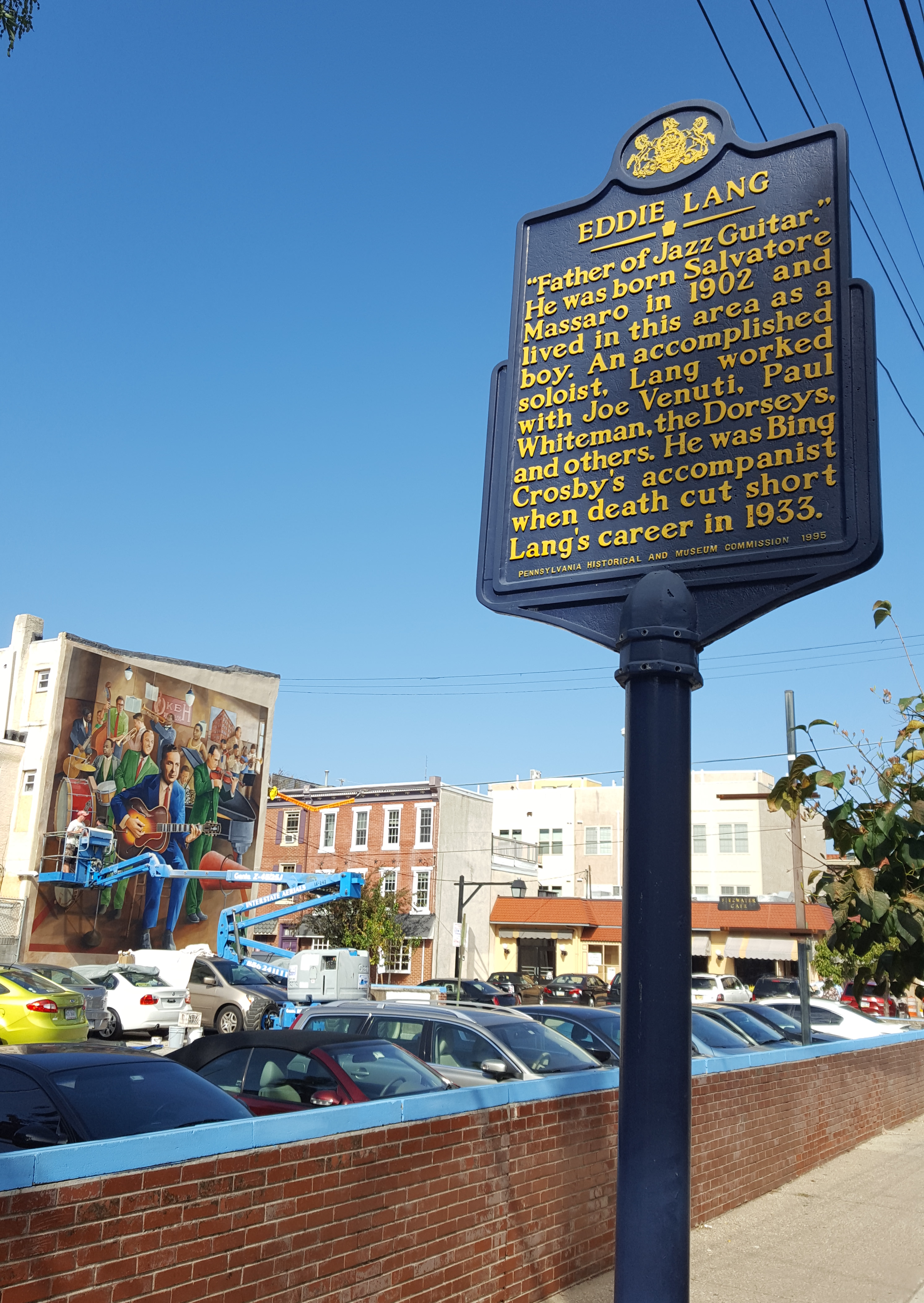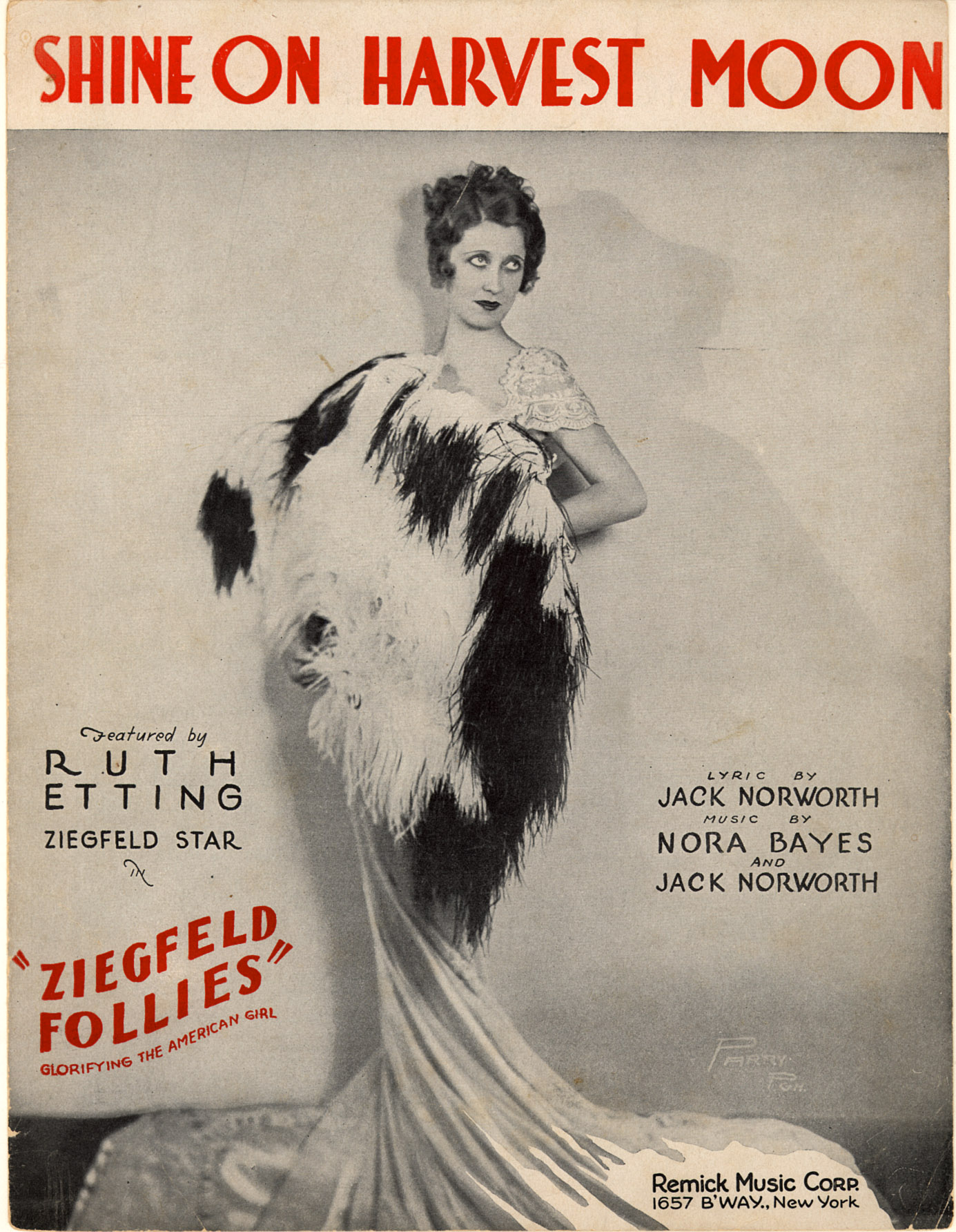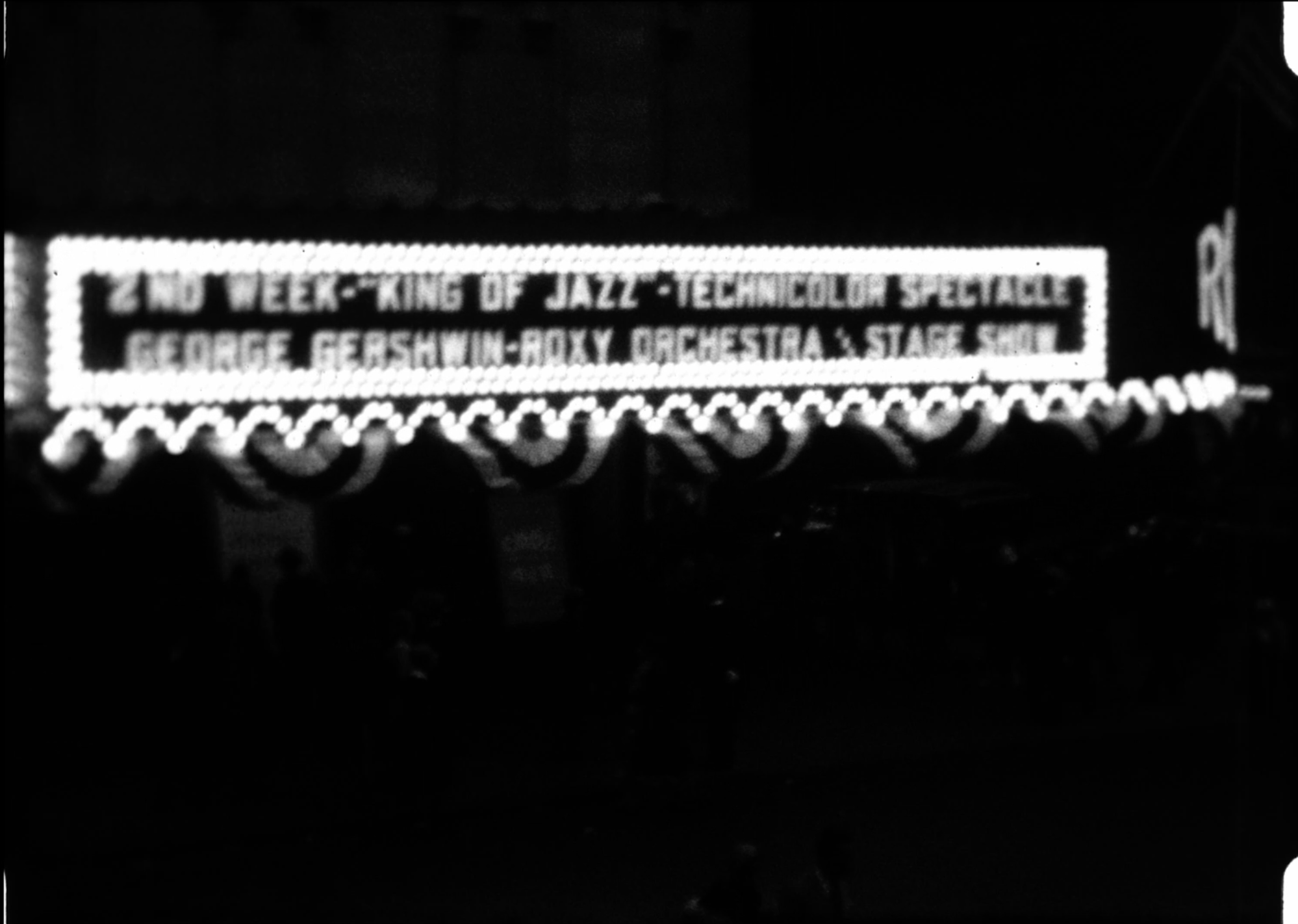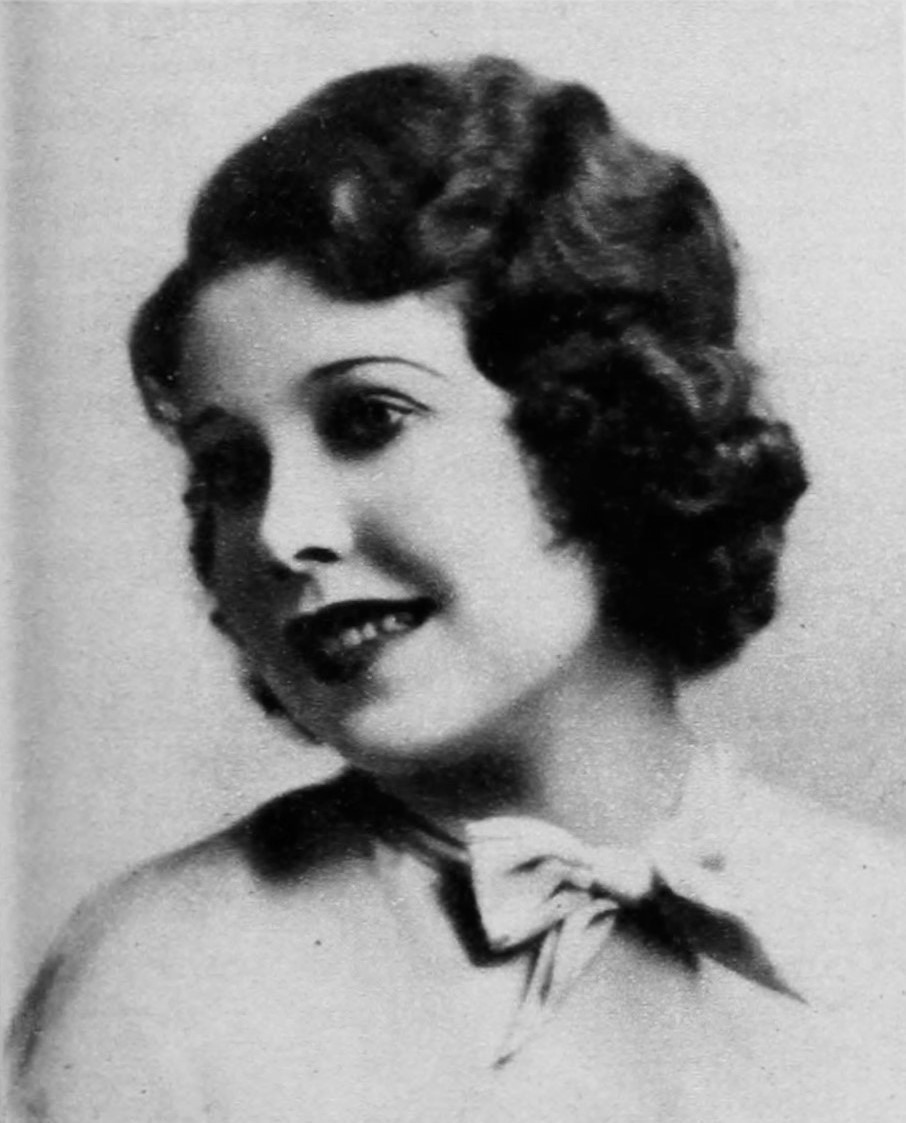|
Eddie Lang
Eddie Lang (born Salvatore Massaro, October 25, 1902 – March 26, 1933) was an American musician who is credited as the father of jazz guitar. During the 1920s, he gave the guitar a prominence it previously lacked as a solo instrument, as part of a band or orchestra, and as accompaniment for vocalists. He recorded duets with guitarists Lonnie Johnson and Carl Kress and jazz violinist Joe Venuti, and played rhythm guitar in the Paul Whiteman Orchestra and was the favoured accompanist of Bing Crosby. Biography The son of an Italian-American instrument maker, Lang was born in Philadelphia, Pennsylvania, and grew up with violinist Joe Venuti. His first instrument was violin when he was seven. He performed on violin in 1917 and became a member of a trio. In 1920, he dropped the violin for banjo and worked with Charlie Kerr, then Bert Estlow, Vic D'Ippolito, and Billy Lustig's Scranton Siren Orchestra. A few years later, he dropped the banjo for guitar when he became a me ... [...More Info...] [...Related Items...] OR: [Wikipedia] [Google] [Baidu] |
Jazz
Jazz is a music genre that originated in the African-American communities of New Orleans, Louisiana in the late 19th and early 20th centuries, with its roots in blues and ragtime. Since the 1920s Jazz Age, it has been recognized as a major form of musical expression in traditional and popular music. Jazz is characterized by swing and blue notes, complex chords, call and response vocals, polyrhythms and improvisation. Jazz has roots in European harmony and African rhythmic rituals. As jazz spread around the world, it drew on national, regional, and local musical cultures, which gave rise to different styles. New Orleans jazz began in the early 1910s, combining earlier brass band marches, French quadrilles, biguine, ragtime and blues with collective polyphonic improvisation. But jazz did not begin as a single musical tradition in New Orleans or elsewhere. In the 1930s, arranged dance-oriented swing big bands, Kansas City jazz (a hard-swinging, bluesy, improvisationa ... [...More Info...] [...Related Items...] OR: [Wikipedia] [Google] [Baidu] |
Adrian Rollini
Adrian Francis Rollini (June 28, 1903 – May 15, 1956) was an American jazz multi-instrumentalist who played the bass saxophone, piano, vibraphone, and many other instruments. Rollini is also known for introducing the goofus in jazz music. As a leader, his major recordings included "You've Got Everything" (1933), "Savage Serenade" (1933) and "Got The Jitters" (1934) on Banner, Perfect, Melotone, Romeo, Oriole, "A Thousand Good Nights" (1934) on Vocalion, "Davenport Blues" (1934) on Decca, "Nothing But Notes", "Tap Room Swing", "Jitters", "Riverboat Shuffle" (1934) on Decca, and "Small Fry" (1938) on Columbia. Early life Rollini was born in New York City on June 28, 1903 of French and Swiss extraction to Ferdinand Rollini and Adele (née Augenti) Rollini. The original family name had been changed to "Rollini" by his grandfather, after a move to Italy during one of Europe's many wars. (Some sources will date 1904, but his brother Arthur Rollini, as well as Social Security A ... [...More Info...] [...Related Items...] OR: [Wikipedia] [Google] [Baidu] |
Guitar Of Eddie Lang L5
The guitar is a fretted musical instrument that typically has six strings. It is usually held flat against the player's body and played by strumming or plucking the strings with the dominant hand, while simultaneously pressing selected strings against frets with the fingers of the opposite hand. A plectrum or individual finger picks may also be used to strike the strings. The sound of the guitar is projected either acoustically, by means of a resonant chamber on the instrument, or amplified by an electronic pickup and an amplifier. The guitar is classified as a chordophone – meaning the sound is produced by a vibrating string stretched between two fixed points. Historically, a guitar was constructed from wood with its strings made of catgut. Steel guitar strings were introduced near the end of the nineteenth century in the United States; nylon strings came in the 1940s. The guitar's ancestors include the gittern, the vihuela, the four- course Renaissance guitar, and the f ... [...More Info...] [...Related Items...] OR: [Wikipedia] [Google] [Baidu] |
The Big Broadcast
''The Big Broadcast'' is a 1932 American pre-Code musical comedy film directed by Frank Tuttle and starring Bing Crosby, Stuart Erwin, and Leila Hyams. Based on the play ''Wild Waves'' by William Ford Manley, the film is about a radio-singer who becomes a popular hit with audiences, but takes a disrespectful approach to his career. His repeated latenesses leads to the bankruptcy of the radio station, but his career is saved by a new friend who buys the station and gives him his job back. The film co-stars George Burns and Gracie Allen in supporting roles. ''The Big Broadcast'' was produced by Paramount Pictures and was the first in a series of four ''Big Broadcast'' movies. Plot Radio-singer Bing Hornsby (Bing Crosby) is not very serious about his career. His chronic tardiness and his soon-to-be marriage with the notorious Mona Lowe (Sharon Lynn) has become an issue at station WADX. After an unpleasant conversation with station manager George Burns, concerning dismissa ... [...More Info...] [...Related Items...] OR: [Wikipedia] [Google] [Baidu] |
Ziegfeld Girl
Ziegfeld Girls were the chorus girls and showgirls from Florenz Ziegfeld's theatrical Broadway revue spectaculars known as the ''Ziegfeld Follies'' (1907–1931), in New York City, which were based on the Folies Bergère of Paris. Description These showgirls followed on the heels of the Florodora girls, who had started to "loosen the corset" of the Gibson Girl in the early years of the 20th century. These beauties, decked out in Erté designs, gained many young male admirers and became objects of popular adoration. All of the showgirls looked very similar, both in appearance and in stature. They danced in complete synchronization, and were the only act that was uniform in the Ziegfeld Follies. Many were persuaded to leave the show to marry, some to men of substantial wealth. The Ziegfeld Ball in New York City continued as a social event of the season for years after the last production of the Follies. In 1897, Ziegfeld married Anna Held, one of his Ziegfeld girls, by com ... [...More Info...] [...Related Items...] OR: [Wikipedia] [Google] [Baidu] |
Rube Bloom
Reuben Bloom (April 24, 1902 – March 30, 1976) was an American songwriter, pianist, arranger, band leader, recording artist, vocalist, and author. Life and career Bloom was born and died in New York City. He was Jewish. During his career, he worked with many well-known performers, including Bix Beiderbecke, Joe Venuti, Ruth Etting, Stan Kenton, Tommy and Jimmy Dorsey. He collaborated with a wide number of lyricists, including Johnny Mercer, Ted Koehler, and Mitchell Parish. During the 1920s he wrote many novelty piano solos, which are still well regarded today. He recorded for the Aeolian Company's Duo-Art reproducing piano system various titles including his "Spring Fever". His first hit came in 1927 with "Soliloquy"; his last was "Here's to My Lady" in 1952, which he wrote with Johnny Mercer. In 1928, he made a number of records with Joe Venuti's Blue Four for OKeh, including five songs he sang, as well as played piano. Bloom formed and led a number of bands during his caree ... [...More Info...] [...Related Items...] OR: [Wikipedia] [Google] [Baidu] |
King Of Jazz
'' King of Jazz'' is a 1930 American Pre-Code Hollywood, pre-Code color musical film starring Paul Whiteman and his orchestra. The film title refers to Whiteman's popular cultural appellation. At the time the film was made, "jazz", to the general public, meant jazz-influenced syncopated dance music heard on phonograph records, on radio broadcasts, and in dance halls. In the 1920s Whiteman signed and featured white jazz musicians including Joe Venuti and Eddie Lang (both are seen and heard in the film), Bix Beiderbecke (who had left before filming began), Frank Trumbauer, and others. ''King of Jazz'' was filmed in the early two-color Technicolor process and was produced by Carl Laemmle Jr. for Universal Pictures. The film featured several songs sung on camera by the The Rhythm Boys, Rhythm Boys (Bing Crosby, Al Rinker and Harry Barris), as well as off-camera solo vocals by Crosby during the opening credits and, very briefly, during a cartoon sequence. ''King of Jazz'' still survi ... [...More Info...] [...Related Items...] OR: [Wikipedia] [Google] [Baidu] |
Snoozer Quinn
Edward McIntosh "Snoozer" Quinn (1907 – April 21, 1949) was a jazz guitarist who was admired by his fellow musicians but who left few recordings. Career Quinn was born Edward McIntosh Quinn in McComb, Mississippi, and raised in Bogalusa, Louisiana. At an early age he could play guitar, mandolin, and violin. In his early teens he performed in vaudeville. He graduated from high school in 1924. He performed with the Paul English Traveling Shows and Peck's Bad Boys led by Peck Kelley, in addition to Claude Blanchard, Mart Britt, the St. Louis Rhythm Kings, and the Louisiana Ramblers. Quinn was hired by Paul Whiteman in New Orleans after Whiteman heard him playing backstage. He recorded with the Whiteman Orchestra, but he can hardly be heard. While playing for vocalist Bing Crosby in the 1930s, Quinn was given the nickname "Snoozer". Although he did not record with Crosby, he recorded with vocalist Bee Palmer and country singer Jimmie Davis. Back in New Orleans, Quinn contra ... [...More Info...] [...Related Items...] OR: [Wikipedia] [Google] [Baidu] |
Clarence Williams (musician)
Clarence Williams (October 6, 1898 or October 8, 1893 – November 6, 1965) was an American jazz pianist, composer, promoter, vocalist, theatrical producer, and publisher. Biography Williams was born in Plaquemine, Louisiana, to Dennis, a bassist, and Sally Williams, and ran away from home at age 12 to join Billy Kersands' Traveling Minstrel Show, then moved to New Orleans. At first, Williams worked shining shoes and doing odd jobs, but soon became known as a singer and master of ceremonies. By the early 1910s, he was a well-regarded local entertainer also playing piano, and was composing new tunes by 1913. Williams was a good businessman and worked arranging and managing entertainment at the local African American vaudeville theater as well as at various saloons and dance halls around Rampart Street, and at clubs and houses in Storyville. Williams started a music publishing business with violinist/bandleader Armand J. Piron in 1915, which by the 1920s was the leading African ... [...More Info...] [...Related Items...] OR: [Wikipedia] [Google] [Baidu] |
Bessie Smith
Bessie Smith (April 15, 1894 – September 26, 1937) was an American blues singer widely renowned during the Jazz Age. Nicknamed the " Empress of the Blues", she was the most popular female blues singer of the 1930s. Inducted into the Rock and Roll Hall of Fame in 1989, she is often regarded as one of the greatest singers of her era and was a major influence on fellow blues singers, as well as jazz vocalists. Born in Chattanooga, Tennessee, Smith was young when her parents died, and she and her six siblings survived by performing on street corners. She began touring and performed in a group that included Ma Rainey, and then went out on her own. Her successful recording career with Columbia Records began in 1923, but her performing career was cut short by a car crash that killed her at the age of 43. Biography Early life The 1900 census indicates that her family reported that Bessie Smith was born in Chattanooga, Tennessee, in July 1892. The 1910 census gives her age a ... [...More Info...] [...Related Items...] OR: [Wikipedia] [Google] [Baidu] |
Red Nichols
Ernest Loring "Red" Nichols (May 8, 1905 – June 28, 1965) was an American jazz cornetist, composer, and jazz bandleader. Biography Early life and career Nichols was born in Ogden, Utah, United States. His father was a college music professor, and Nichols was something of a child prodigy, playing difficult set pieces for his father's brass band by the age of 12. Young Nichols heard the early recordings of the Original Dixieland Jazz Band and later those of Bix Beiderbecke, and these had a strong influence on him. His style became polished, clean, and incisive. In the early 1920s, Nichols moved to the Midwest and joined a band called the Syncopating Seven. When that band broke up, he joined the Johnny Johnson Orchestra and went with it to New York City in 1923. In New York, he met trombonist Miff Mole, and the two were inseparable for the next decade. Before signing with Brunswick, Nichols and Mole recorded for Pathé-Perfect under the name the Red Heads. Brunswick Record ... [...More Info...] [...Related Items...] OR: [Wikipedia] [Google] [Baidu] |
Annette Hanshaw
Catherine Annette Hanshaw (October 18, 1901 – March 13, 1985) was an American Jazz Age singer. She was one of the most popular radio stars of the late 1920s and early 1930s. Over four million of her records had been sold by 1934. In her ten-year recording career, she recorded about 250 sides. In a 1934 poll conducted by ''Radio Stars'' magazine, she received the title of best female popular singer (Bing Crosby was voted the best male popular singer). Second place went to Ethel Shutta, third place went to Ruth Etting, and fourth place went to Kate Smith. Biography Catherine Annette Hanshaw was born on October 18, 1901 to Frank Wayne Hanshaw and Mary Gertrude McCoy in their residence in Manhattan. She had two brothers, George and Frank. Her aunt and uncle, Nellie McCoy and Bob "Uke" Hanshaw, were vaudeville performers. She sang for guests at hotels owned by her father and demoed sheet music at her family's music store, The Melody Shop, in Mount Kisco, Westchester County, Ne ... [...More Info...] [...Related Items...] OR: [Wikipedia] [Google] [Baidu] |


.jpg)




